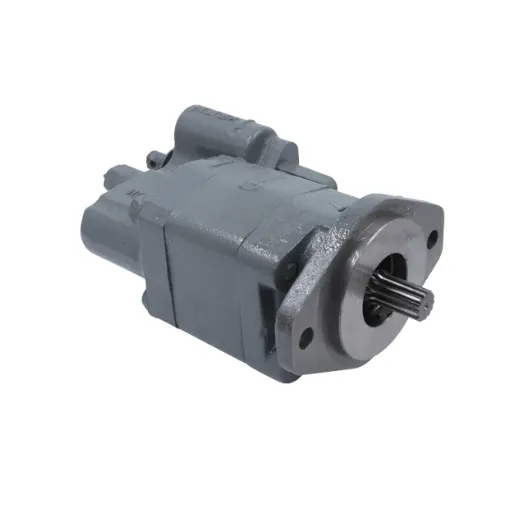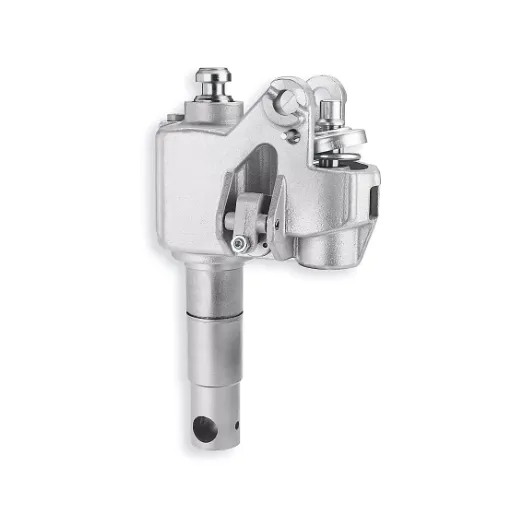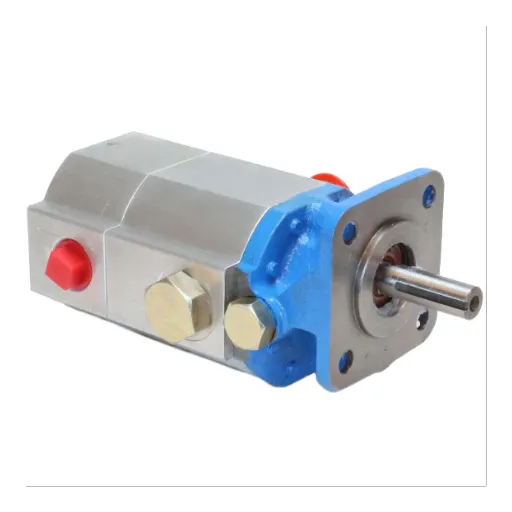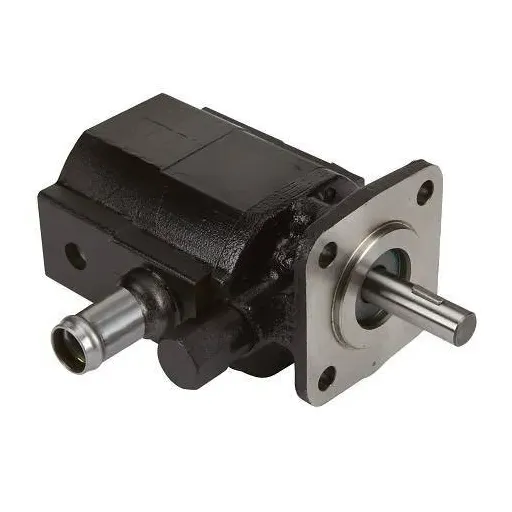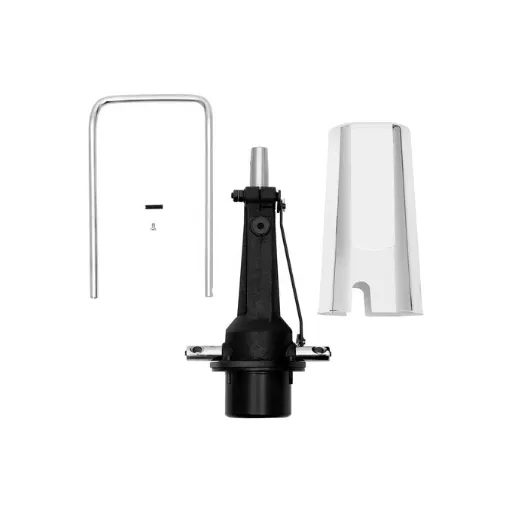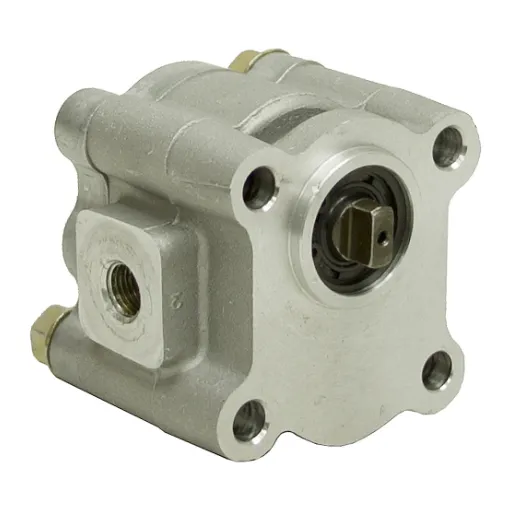The pump has been considered the heart of the hydraulic system of a dump truck, ensuring the smooth lifting and tilting of heavy loads these workhorses are famous for removing. Working in construction, mining, or agriculture, one needs to understand the working and maintenance of a dump truck hydraulic pump to make it productive and avoid costly downtime. This article will guide you through the basics of hydraulic pumps, investigating their various types, primary functions, and maintenance. We’ll walk you through some common troubleshooting tips so you can get them fixed fast and right. Whether on the job for many years or one now entering the field, this exhaustive manual will attune you to everything you need to know about this critical component.
The Role of the Hydraulic Pump in Dump Trucks

Fundamental Function within the Hydraulic System
The hydraulic pump is one of the major parts on any dump truck, this pump produces pressure in the hydraulic system when it is working. It converts mechanical energy from the truck’s engine into hydraulic energy used to lift and lower the truck bed. The operation of the hydraulic system is precisely controlled to handle heavy loads efficiently.
With the pump on, it pushes the fluid through the circuit ensuring that a constant flow is maintained throughout its operation. This flow generates the force needed to move the hydraulic components of the truck, such as cylinders which lift and tilt the dump body. If the pump fails, the system will not be able to generate enough pressure to carry out the necessary movements.
The reliability and efficiency of the hydraulic pump lead to an efficient set of dump trucks while improper operation leads to ineffectiveness. With regular inspections, fluid check, and other repairs whenever needed, breakdowns could be avoided and smooth operation ensured. Knowing the key role of the hydraulic pump, the operator can maximize utilization and minimize downtime; hence, it remains the key component of any hydraulic system in a dump truck.
Importance of the Hydraulic Dump Pump for Efficiency
This hydraulic dump pump especially must rightly be called the very functionary of dump trucks; it is the power that drives load-bearing platforms up and down. If this component should malfunction, simple unloading of materials would become a time-consuming and strenuous task, thus posing a great constraint on the productivity on job sites. Hydraulic dump pump acts toward smooth and precise control of movement in rising and lowering the load platform.
Efficiency is greatly improved in service by carefully looking after your hydraulic pump. Such a pump in good order does not lay heavy burdens on remaining parts of the hydraulic system, thus they consume less energy and wear. Regular maintenance including checking hydraulic-fluid levels and replacement of worn-out parts ensure good operation. Consequently, this will imply fewer instances of operational disruptions and less maintenance in the near future.
In terms of safety, the reliability of the hydraulic dump pump is paramount. A malfunctioning pump can result in uncontrolled or incomplete lifting of the truck bed, thus potentially endangering both operator and equipment. If operators accord this critical component a high degree of maintenance, they will be striking a fine balance between operational efficiency, cost-effectiveness, and safe working conditions, thereby making the hydraulic dump pump an absolute necessity for any dump truck system.
Impact on Faster Cycle Times
The hydraulic dump pump ensures impediment-free and smooth functioning, thereby reducing cycle time. Cycle time optimization directly influences production, resulting in a higher number of loads being handled in a shorter time period. Following are five pertinent factors explaining the role of hydraulic dump pumps in improved cycle time:
- Efficient Hydraulic Flow: A hydraulic dump pump, if correctly designed, can provide consistent fluid flow, thus reducing the time taken to raise and lower the truck bed.
- High-Speed Operations: The engineering that goes into hydraulic systems aids in fast reaction to application and disentanglement of the lifting action.
- Less Downtime with Quality Components: With a high-grade hydraulic pump, breakdowns rarely occur, meaning operations continue undisturbed.
- Precision and Control: Better control of movements in new hydraulics prevents delays incurred when movements are imprecise or too slow.
- Energy Optimization: Energy-efficient hydraulic dump pumps help minimize wasted energy, maximizing system performance, and speeding up the entire loading and dumping cycle.
Focusing on these factors provides operators with very real improvements in cycle time, thus generating efficiency and savings in the cost of operations.
Types of Dump Truck Hydraulic Pumps

Gear Pumps: Characteristics and Applications
A standard hydraulic pump in dump truck applications due to its simplistic function, durability, and efficiency. The functioning principle of gear pumps relies on the intermeshing of gears to produce a flow of hydraulic fluid that maintains steady working operations of the system. Robust in nature, this brand of pump is well suited for heavy-duty applications in bad operating conditions.
They thus form a critically important element in gear pump design due to the requirement of precise hydraulic control while loading and unloading. More so, they are small in size, less expensive, and very easy to maintain, so minimizing downtime and operating costs. Gear pumps, depending on the design and material used, usually work up to a pressure capability of about 3000 psi and so are suitable for medium to fairly high-pressure dump truck applications.
Applying gear pumps to dump trucks, the scenarios revolve around utilitarian applications such as the raising and lowering of the truck bed quickly and more efficiently under heavy loads. These pumps carry great importance for ensuring a uniform flow rate is maintained even if conditions alter. The best gear pumps, combined with modern materials and methods, lay a path towards great energy efficiency and long life, and these ideals are the foundation of sustainability and performance optimization in the modern industry.
Vane Pumps: Advantages and Use Cases
This kind of pump is universally acclaimed for its versatility and cost-efficiency in a number of industries. It consists of cavity vanes installed on a rotor with which it moves the fluid, retaining it first and dispatching it from the inlet to the outlet ports. One advantage being that they handle thin fluids, so to speak, having low viscosity, while retaining volumetric efficiency. They also bring about a uniform flow rate with a low degree of pulsation, very desirable for precision-based operations that reduce wear and tear on components attached thereto.
Vane pumps find widespread employment in systems where a silent, smooth, and effective performance is required, such as automotive, aviation, and hydraulic machinery applications. They can manage a wide range of pressure demands due to their self-adjusting vane system, which ensures that the working conditions are always at optimum flow, given the changing parameters. Developments in vane pump design and building materials, advanced coatings, and long-life construction have contributed to extended life and improved energy efficiency. These continuously evolving features place the vane pumps as a competitive and sustainable choice in present industrial challenges.
By virtue of their compact design and relatively simple maintenance, they become a great addition to any business wishing to keep down-time low and cut operational costs. For applications with higher pressures but that require an even output, vane pumps stand out as a good and capable solution.
Piston Pumps: Performance and Efficiency
With respect to their superior performance, high efficiency, and ability to handle all varieties of fluids, piston pumps stand to be chosen in the most difficult industrial applications. The fluid is displaced and pressurized by these pumps with reciprocating pistons inside a cylinder, allowing it to reach very high pressures and being exact in controlling. Especially in applications where the output is expected to be constant, piston pumps work better than any other pump. Manufacturing, oil and gas, and hydraulic systems are just those areas where dependable and tough performances are utmost essential.
Piston pumps are highly efficient, which is one of their biggest advantages. Their construction ensures minimum energy loss so that maximum hydraulic output is generated for the amount of power fed in. The greater efficiency also helps reduce the costs of operations and caters to the current demand for energy-efficient industrial machinery. These piston pumps could slug away at liquids having dry viscosity practically from that of water to quite viscous oils or sludges, providing a versatile solution to diverse operational requirements. The evolving materials and design concepts have further enhanced the potentials of such pumps, allowing them to operate under harsh conditions and improving the operational lifespan.
Maintenance and customization are both considered the key strengths of piston pumps. They need continual maintenance because of their fairly complicated mechanical components; however, improvements in sealing technologies and materials have decreased wear on these parts and have allowed longer to pass between required maintenance. Furthermore, these pumps can be customized to suit the demands of the application, which might include flow rates, pressure levels, and the nature of the fluids concerned. Surely, such adaptability coupled with superior performance and efficiency renders piston pumps an indispensable asset for industries that emphasize productivity, green production, and precise fluid control.
Preventative Maintenance for Hydraulic Dump Pumps
Routine Inspections and Fluid Checks
Hydraulic dump pumps must go through routine inspections and fluid-level checks to ensure their longevity and efficient working. Checking the system for visible signs of wear, leaks, or damage on regular intervals prevents costly breakdowns and even enhances operational efficiency. In fact, hoses, seals, connections, and other important components must be checked during inspection to recognize any issues in their infancy. A proactive approach to maintenance saves downtime and prevents sudden failures, especially in heavy industrial operating conditions.
Fluid checks constitute another major preventive maintenance measure performed on a hydraulic dump pump. By monitoring hydraulic fluid levels, a governing system is maintained at recommended, thus preventing excessive wear of the internal components. It is equally important to maintain fluid cleanliness. Dirt, metal particles, and water contaminants will hamper good system performance and almost hasten component failure. Using a filtration system and periodically performing fluid sample analyses remain poor practices to protect the pump against damage by impurities.
Routine inspections and fluid checks will be of important benefit when performed according to a maintenance schedule prepared for the specific pump model and application. Records are thereby maintained of maintenance activities, fluid changes, and any other problems that have been observed. In combination with the improvements that have been made in predictive maintenance, monitoring-type sensors, and real-time monitoring tools, this has created a conjunction of factors contributing to reduction in repair costs, enhancement of system reliability, and keeping this hydraulic dump pump a very efficient and dependable hydraulic tool used in industrial operations.
Best Practices to Prolong Pump Lifespan
While insuring the hydraulic dump pump for long life and better working, a defined approach to care and maintenance must be followed. Checking for wear or damage and leaks all such early inspections can provide a warning against any greater compromise. One must keep the hydraulic oil clean by changing fluids as and when due and using good filters so that the contamination does not degrade the system. Another essential key lets keep track of the temperature while operating near the pump, as it can lose efficiency away and let paramount damage occur within.
The alignment of the pump and the motor should be proper to reduce vibration and short mechanical stress leading to long-term damage. The pump should also be operated within its set pressure and flow rate limits, or else any overloading on the system can cause premature failures. Using advanced diagnostic tools such as vibration analyzers and infrared thermography would help in identifying the irregularities correctly, thus allowing maintenance to take place with foresight.
An investment in training ensures that operators understand the proper techniques as well as recognize the early signs of wear or inefficiencies. When they are executed systematically, these practices along with modern technologies extend the life of hydraulic dump pumps and guarantee their reliability and cost-effectiveness in industrial applications.
⚠️ Common Signs of Wear and Tear
Unless one understands wear and tear signs in hydraulic dump pumps, one cannot maintain it for optimal functionality and may ultimately have to bear costly downtimes. Some common indicators are:
- Leaks: Usually seen leaks of fluid around seals and joints raise indications of worn-out components or improper sealing.
- Slow Operation: A drop in the normal functioning of the pump to lift or dump slowly may constitute internal wear or poor hydraulic fluid quality.
- Unusual Noises: Should you hear grinding, whining, or knocking sounds, you could be facing mechanical damage, cavitation, or lack of lubrication.
- Overheating: Excess heat generation may be due to fluid contamination, overloading, or incorrect pressure settings in the system.
- Erratic Movement: Jerky or uneven motion during operation may point to air in the hydraulic fluid or faulty valves.
Operators can make sure of the longevity and reliability of these hydraulic dump pumps while reducing operational costs by keeping a close watch on these signs and maintenance work on a preventative basis. Properly scheduled inspections and the use of current diagnostic tools help provide deeper insight into possible problems, allowing for proactive corrections before failures occur.
Troubleshooting Common Issues with Hydraulic Pumps

Identifying and Fixing Leaks
Leakages in the hydraulic pumps are one of the most common problems faced by operators, and the prevention of such leakage ensures efficient functioning of the system where leakage occurs. To identify leakage, one must begin with the visual inspection of hoses, fittings, seals, and connections for any fluid seepage and hence the accumulation of dirt. Leaks are generally seen as puddles underneath the system or damp patches along the equipment. Make it a habit to frequently check the hydraulic fluid level since a drop in level can also indicate a leak.
Once a leak is found, the exact location and cause of the leakage require determination. A leaking hose or loose fitting is often easily fixed by tightening the connections or replacing the damaged components. Worn seals, on the other hand, require disassembling of that pump section and fitting of new seals. Manufacturer-recommended parts should be used to ensure compatibility and reliable performance.
Hidden leakages occurring in complex hydraulics systems can be detected through modern methods such as ultrasonic leak detection or infrared cameras and maybe others. With these technologies, a leak can be located rather than requiring several hours of equipment disassembly and assembly. Retrofitting prevents the wear of other components due to leaks, fluid wastage, and to ensure that the hydraulic pump works efficiently.
Addressing Loss of Pressure Problems
Pressure loss in hydraulic systems can hugely affect machinery efficiency, performance, and the general safety of operations. Pressure loss can result from the appearance of worn-out seals, faulty pumps, or fluid leaks in excess; any of these situations make the system perform below its optimum capacity. Speedily attending to the cause of pressure loss reduces equipment downtime and helps to prevent further damage. Keeping a count of system operations and performance, through various tests, will alert the operator much ahead. In addition, pressure sensors and flow meters are among advanced tools that should be used for the diagnosis; these will also give instant feedback on how the system is behaving so that troubleshooting can be expedited.
Another common cause of pressure loss is the contamination of hydraulic fluids. Particles, air, or water in hydraulic fluid can impair the quality of the fluid, leading to inefficiency and loss of pressure. Such risks are avoided by high-grade filtration and changing the fluid regularly. Employing predictive maintenance methods like condition monitoring and particle counting will proactively enable one to take intervention and thus avoid the risk of failure in the entire system.
The modern technology provides further enhancement addressing pressure-related problems through the smart hydraulic systems. These advanced systems use IoT sensors and cloud monitoring to monitor pressure levels, fluid quality, and system performance on a continuous basis. Auto alerts generate instances of abnormalities when operators can immediately take action. Such a system combined with regular maintenance ensures hydraulic systems remain reliable, efficient, and unaffected by pressure problems. Thus, pressure-related issues can be handled effectively, thus contributing to increased operational efficiency, by employing both traditional maintenance methods and cutting-edge technologies.
Resolving Unusual Noises and Their Causes
Unusual sounds in hydraulic systems mostly signal underlying problems that require quick action in order to avoid further damage or system breakdown. Such sounds as hammering, whining, or strong vibrations can be attributed to various reasons, among which are cavitation, aeration, and obsolescent parts. The process of cavitation happens when vapor bubbles form in the hydraulic liquid because of sudden pressure dropping which results in a loud banging or knocking sound. Conversely, aeration which occurs because of air contamination in the liquid, produces a whining or hissing sound. It is crucial to find the source of the noises in the hydraulic system so that the problem can be solved and the system can keep running productively.
Periodical checking and servicing would be very helpful in detecting and solving such problems at an early stage. The operator dealing with the cavitation-related noise should look for places where fluid flow is restricted, and filters are blocked or incorrectly sized or positioned components that lead to pressure drops. If aeration is the cause, air leaks in the system have to be searched for, fluid levels have to be kept at the right level, and only a high-quality fluid that does not allow air entrapment should be used. Furthermore, worn or broken parts like failure of bearings in pumps or motors can lead to loud noises and should be replaced immediately to avoid further wear and tear on the equipment and hydraulic system damage.
Advanced diagnostic and monitoring technologies can also play a major role in the early detection of unconventional noises and their causes. Acoustic sensors and vibration analyzers are of great assistance in finding out the exact noise patterns and locating the areas of concern within the system. By using these technologies and combining them with a proactive maintenance schedule, plant operators can significantly cut downtime and repair costs. Timely treatment of strange noises not only boosts system performance but also prolongs the service life of essential hydraulic components in general.
Choosing the Right Hydraulic Dump Pump for Your Vehicle

Factors to Consider: Flow Rate and Pressure Ratings
If you want to choose a hydraulic dump pump for your automobile, the knowledge of flow rate and pressure ratings is vital to get the best performance and the compatibility of the pump. The flow rate, which is usually expressed in gallons per minute (GPM), is the quantity of hydraulic fluid that the pump can circulate in a certain period of time. It is very important to match the flow rate of the pump with the requirements of your hydraulic system, as insufficient or too high flow may cause inefficiency or damage to the system.
Pressure ratings, measured in pounds per square inch (PSI), tell how much power the pump can use for doing jobs like lifting or moving heavy loads. Going above the pressure limit for your system may cause leaks, seal breakage, or mechanical wear, while low pressure will prvent task from being done.
Make sure that the specifications for flow and pressure of the pump are the same as those of your vehicle’s hydraulic system as per manufacturer’s recommendation. Moreover, it is necessary to consider the operating conditions such as ambient temperature and fluid viscosity in order to get consistent and efficient operation of the pump throughout its service life. The combination of these factors and accurate load calculations will ensure safety and reliability in system performance.
Compatibility with Your Dump Truck Model
When determining the suitability of a hydraulic pump for your dump truck model, I take into account a number of technical factors carefully. To begin, I check the flow rate of the pump and the ratings for the pressure, making sure that they are in accordance with the specifications given by the truck manufacturer. This is essential in preventing mismatches that can not only affect the performance of the system but also cause early wear of the components. The connections, namely the inlet and outlet ports, have to be compatible with the hydraulic setup for smooth integration to be assured.
After that, I take into consideration the working environment of the dump truck. The temperature range, load variations, and the type and viscosity of the hydraulic fluid are some of the factors to consider. For example, if the truck is located in an extreme climate, I would select a pump that can bear the temperature changes without its performance being negatively affected. Moreover, I also check that the pump I have selected is compatible with the hydraulic fluid being used to prevent any problems like cavitation or inefficiency.
Finally, I take into account the particular application needs of the dump truck. If the truck is working in construction, mining, or just general hauling, then the design of the hydraulic system has to be such that it can meet the workload demands. Doing load calculations and analyzing duty cycles are two ways that help me ascertain whether the pump will be able to work for long periods without overheating or failing. By considering these factors methodically, I make sure that the hydraulic pump has the best compatibility and that the truck’s operational requirements determine its reliable performance.
Frequently Asked Questions (FAQ)
Q: What is a dump truck hydraulic pump?
A: A dump truck hydraulic pump is an essential part of the dump truck systems that changes mechanical energy into hydraulic energy. The dump truck hydraulic pump has taken control over the hydraulic devices for lifting and lowering the truck bed, thereby unloading the site of construction materials in an efficient manner.
Q: How does a PTO work in relation to a dump truck hydraulic pump?
A: The power take-off (PTO) is a very important mechanism that links the engine of the truck to the dump truck hydraulic pump. It makes it possible for the engine’s mechanical energy to turn the pump, thus the hydraulic system is able to work correctly. The right positioning of the PTO makes it so that the pump is running at its most efficient during the loading and unloading processes.
Q: What are common pump issues in dump truck hydraulic systems?
A: Amongst the most frequent problems experienced with hydraulic pumps of dump trucks are leaking near the pump housing, air in the system causing poor performance, and pump inefficiency. Regular maintenance consisting of looking for leaks, having high-pressure connections, and so on will not only save you the cost of pump replacement but also increase the life of your dump trucks and their performance.
Q: How can I enhance the efficiency of my dump truck hydraulic pump?
A: To enhance the efficiency of a dump truck hydraulic pump, one must carry out regular maintenance and pick the best pump type that suits their needs. Using hydraulic services for routine checks and changing worn-out parts can stop performance issues and lengthen the pump lifespan.
Q: What types of hydraulic pumps are available for dump trucks?
A: There are many different kinds of hydraulic pumps utilized in dump trucks, which include gear pumps, piston pumps, and vane pumps. Each type has its distinct benefits and is tailored to handle different levels of performance and reliability that are necessary for dump trucks.
Q: What is the role of a control valve in a dump truck hydraulic system?
A: A control valve in a dump truck hydraulic system is responsible for directing the pressurized hydraulic fluid to the dump bed’s actuator, therefore, making the flow of lifting and lowering very smooth, thus playing a very important role in controlling the entire dump truck hydraulic system.
Q: How does proper maintenance affect the reliability of a dump truck hydraulic pump?
A: Proper maintenance practices such as performing regular leak inspections, checking the hydraulic tank fluid levels, and changing worn seals and gaskets, all contribute to a considerable increase in the reliability of a dump truck hydraulic pump. The taking of preventive measures can lead to the full utilization of the pump’s life and hence the pump will always produce its best output.
Q: What are the signs that my dump truck hydraulic pump needs repair?
A: The signs that point to the fact that your dump truck hydraulic pump needs to be repaired are strange sounds coming from the pump, slow or no hydraulic movements at all, pump leaks, and reduced pump efficiency. It is very important to tackle these issues quickly so as not to cause any further damage.
Q: How can I select the right hydraulic pump for my dump truck?
A: Choosing a hydraulic pump for your dump truck is a process that demands the consideration of the pump type, required flow rate, and pressure specifications as the main factors. Getting a professional hydraulic expert involved in the selection would help you in making the right choice of the most suitable options that will assure you of reliable operation and optimal pump performance.



